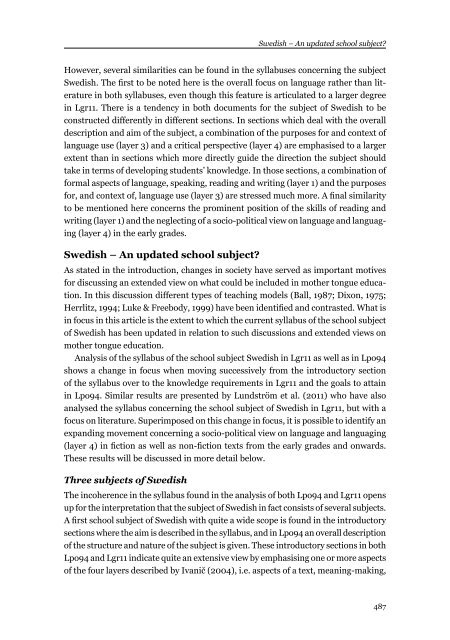Download issue - Lärarutbildning - Umeå universitet
Download issue - Lärarutbildning - Umeå universitet
Download issue - Lärarutbildning - Umeå universitet
You also want an ePaper? Increase the reach of your titles
YUMPU automatically turns print PDFs into web optimized ePapers that Google loves.
Swedish – An updated school subject?<br />
However, several similarities can be found in the syllabuses concerning the subject<br />
Swedish. The first to be noted here is the overall focus on language rather than literature<br />
in both syllabuses, even though this feature is articulated to a larger degree<br />
in Lgr11. There is a tendency in both documents for the subject of Swedish to be<br />
constructed differently in different sections. In sections which deal with the overall<br />
description and aim of the subject, a combination of the purposes for and context of<br />
language use (layer 3) and a critical perspective (layer 4) are emphasised to a larger<br />
extent than in sections which more directly guide the direction the subject should<br />
take in terms of developing students’ knowledge. In those sections, a combination of<br />
formal aspects of language, speaking, reading and writing (layer 1) and the purposes<br />
for, and context of, language use (layer 3) are stressed much more. A final similarity<br />
to be mentioned here concerns the prominent position of the skills of reading and<br />
writing (layer 1) and the neglecting of a socio-political view on language and languaging<br />
(layer 4) in the early grades.<br />
Swedish – An updated school subject?<br />
As stated in the introduction, changes in society have served as important motives<br />
for discussing an extended view on what could be included in mother tongue education.<br />
In this discussion different types of teaching models (Ball, 1987; Dixon, 1975;<br />
Herrlitz, 1994; Luke & Freebody, 1999) have been identified and contrasted. What is<br />
in focus in this article is the extent to which the current syllabus of the school subject<br />
of Swedish has been updated in relation to such discussions and extended views on<br />
mother tongue education.<br />
Analysis of the syllabus of the school subject Swedish in Lgr11 as well as in Lpo94<br />
shows a change in focus when moving successively from the introductory section<br />
of the syllabus over to the knowledge requirements in Lgr11 and the goals to attain<br />
in Lpo94. Similar results are presented by Lundström et al. (2011) who have also<br />
analysed the syllabus concerning the school subject of Swedish in Lgr11, but with a<br />
focus on literature. Superimposed on this change in focus, it is possible to identify an<br />
expanding movement concerning a socio-political view on language and languaging<br />
(layer 4) in fiction as well as non-fiction texts from the early grades and onwards.<br />
These results will be discussed in more detail below.<br />
Three subjects of Swedish<br />
The incoherence in the syllabus found in the analysis of both Lpo94 and Lgr11 opens<br />
up for the interpretation that the subject of Swedish in fact consists of several subjects.<br />
A first school subject of Swedish with quite a wide scope is found in the introductory<br />
sections where the aim is described in the syllabus, and in Lpo94 an overall description<br />
of the structure and nature of the subject is given. These introductory sections in both<br />
Lpo94 and Lgr11 indicate quite an extensive view by emphasising one or more aspects<br />
of the four layers described by Ivanič (2004), i.e. aspects of a text, meaning-making,<br />
487

















